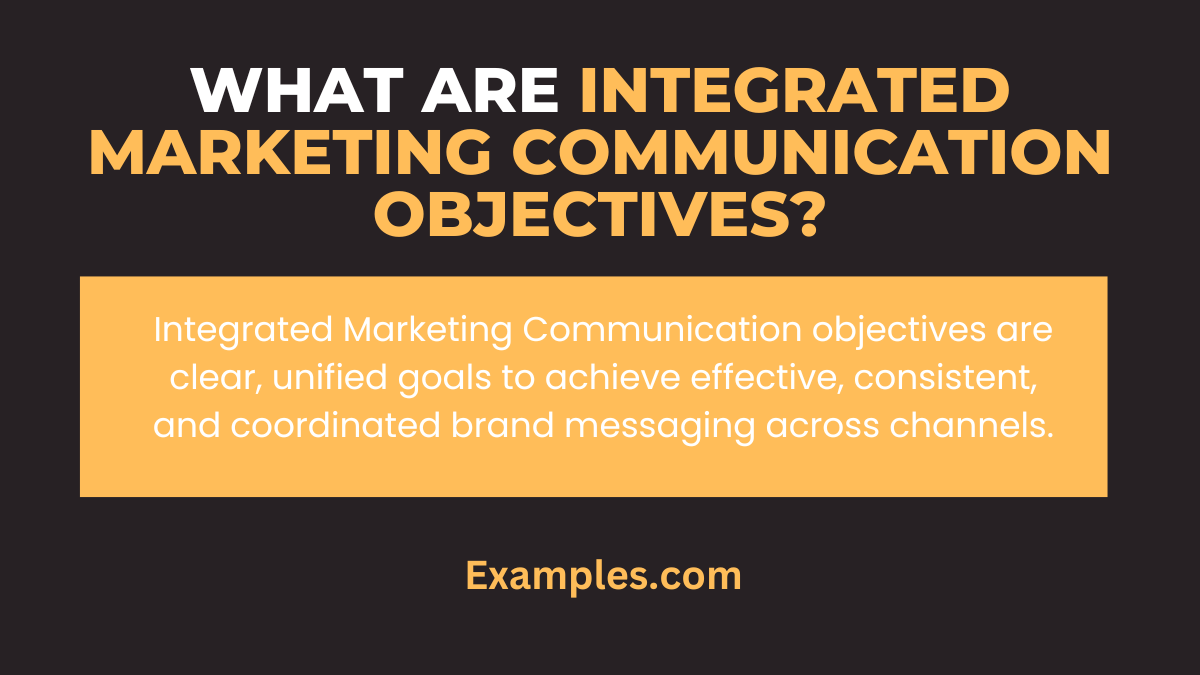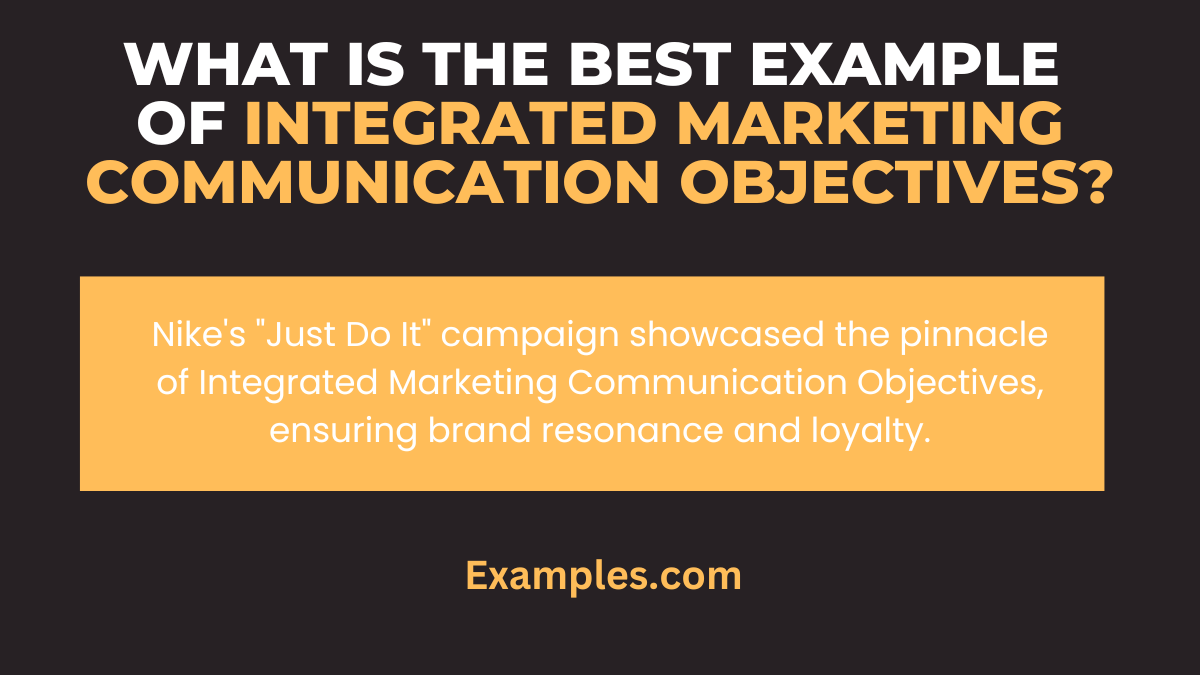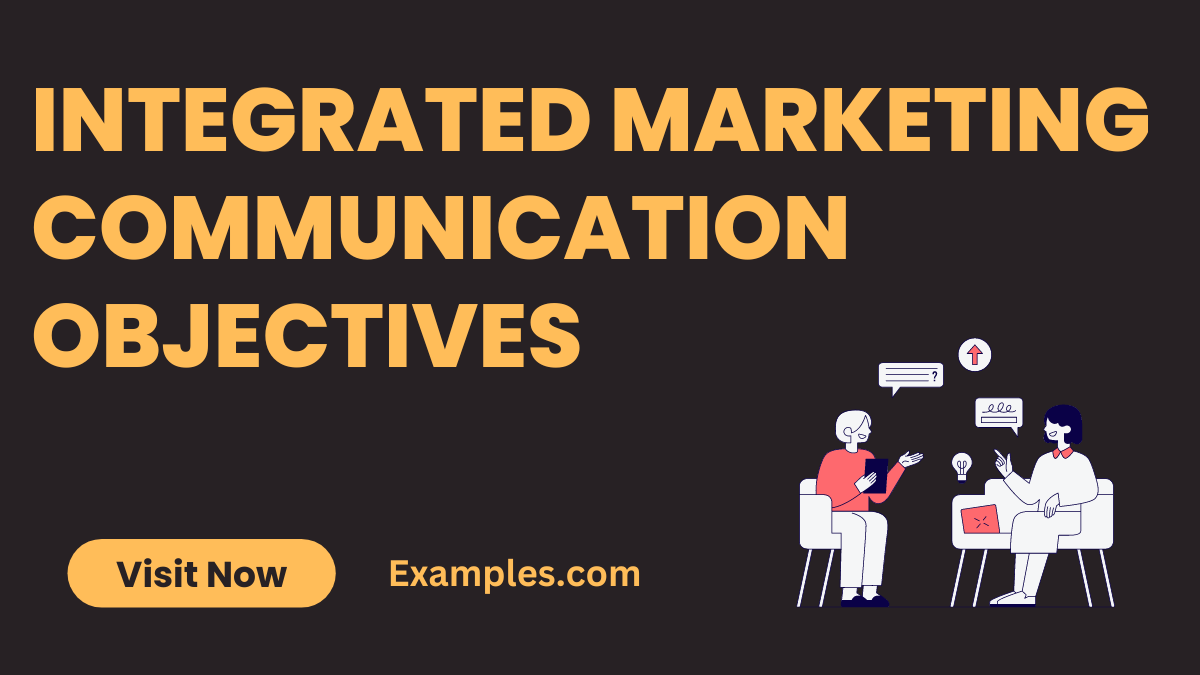19+ Integrated Marketing Communication Objectives Examples
Unlock the realm of effective marketing strategies with this comprehensive guide on Integrated Marketing Communication Objectives. Delve into real-world Communication Examples, master the art of setting objectives, and optimize your approach for unparalleled success in the dynamic landscape of marketing. Explore the intricacies of aligning objectives with overall business goals, fostering brand consistency, and creating engaging campaigns that resonate with your target audience. Elevate your marketing prowess with insights, tips, and best practices.
What is Integrated Marketing Communication Objectives?

Integrated Marketing Communication Objectives refer to strategic goals set by businesses to synchronize and unify their communication efforts across various channels. These objectives aim to create a cohesive and impactful brand message, ensuring consistency and effectiveness in reaching the target audience.
What is the Best Example of Integrated Marketing Communication Objectives?

Witness the power of Integrated Marketing Communication Objectives through the exemplary case of Nike’s “Just Do It” campaign. By seamlessly integrating their messaging across TV, print, digital, and experiential platforms, Nike created a consistent narrative that not only resonated with their audience but also established a timeless and iconic brand image. This campaign exemplifies the successful alignment of communication objectives with brand identity, fostering customer loyalty and engagement.
20 Integrated Marketing Communication Objectives Examples

Explore the dynamic landscape of marketing through these Integrated Marketing Communication Objectives examples. Each instance showcases the strategic alignment of goals and communication efforts, emphasizing brand consistency and customer engagement. Gain valuable insights into crafting effective objectives that resonate across diverse channels and leave a lasting impact.
- Nike’s “Just Do It” Campaign: Motivate audiences with a universal message, urging them to take action and embrace their full potential. Example: Inspire your audience by urging them to conquer challenges, just like Nike’s empowering “Just Do It” campaign.
- Coca-Cola’s “Share a Coke” Initiative: Personalize the brand experience by incorporating individual names on product labels. Example: Enhance customer connection by embracing personalization, as demonstrated by Coca-Cola’s endearing “Share a Coke” campaign.
- Apple’s Product Launch Events: Build anticipation and excitement around product launches through carefully orchestrated events. Example: Create a buzz around your products with captivating launch events, mirroring Apple’s successful communication strategy.
- Dove’s “Real Beauty” Campaign: Challenge beauty norms and promote inclusivity by celebrating diverse representations. Example: Champion inclusivity and redefine beauty standards, following Dove’s impactful “Real Beauty” campaign.
- Old Spice’s Humorous Marketing: Infuse humor into communication to entertain and engage your audience effectively. Example: Master the art of humor to captivate your audience, drawing inspiration from Old Spice’s witty and memorable marketing approach.
- Google’s “Year in Search” Videos: Reflect on the year’s notable events, connecting emotionally with users. Example: Evoke emotions and connect with your audience by crafting annual reflection videos, inspired by Google’s “Year in Search.”
- Red Bull’s Extreme Sports Sponsorships: Align with high-energy activities to reinforce brand attributes and values. Example: Forge connections with your target audience through strategic sponsorships in adrenaline-fueled domains, akin to Red Bull’s extreme sports engagements.
- Starbucks’ Seasonal Campaigns: Leverage seasonality to introduce limited-time offerings and engage customers. Example: Create excitement with seasonal campaigns, introducing unique offerings just like Starbucks’ celebrated seasonal releases.
- IKEA’s Interactive Catalogs: Embrace technology to create interactive and engaging content for customers. Example: Enhance customer engagement with interactive catalogs, taking cues from IKEA’s innovative approach to digital communication.
- Budweiser’s Emotional Storytelling: Tell compelling stories that resonate emotionally, connecting with your audience. Example: Forge emotional connections through storytelling, following Budweiser’s heartwarming and impactful narrative approach.
- Amazon’s Prime Day Extravaganza: Introduce exclusive events to reward loyalty and drive sales. Example: Foster customer loyalty and boost sales through exclusive events, mirroring the success of Amazon’s Prime Day extravaganza.
- Lego’s User-Generated Content: Encourage user participation by showcasing creations made by customers. Example: Celebrate customer creativity by featuring user-generated content, inspired by Lego’s engaging approach.
- GoPro’s Customer Testimonials: Amplify brand credibility by sharing authentic customer experiences and testimonials. Example: Build trust and credibility through customer testimonials, as demonstrated by GoPro’s impactful communication strategy.
- Oreo’s Real-time Marketing: Capitalize on real-time events to create timely and relevant content. Example: Stay relevant with real-time marketing, following Oreo’s successful approach during events like the Super Bowl blackout.
- Airbnb’s Community Engagement: Foster a sense of community by highlighting user-generated content and experiences. Example: Build a strong community by showcasing user-generated content and experiences, aligning with Airbnb’s community-driven ethos.
- Tesla’s Product Unveils: Create anticipation and generate buzz through strategic product unveilings. Example: Generate excitement around your products with strategic unveilings, taking inspiration from Tesla’s impactful launches.
- Disney’s Cross-promotion: Leverage a diverse portfolio to cross-promote content and offerings. Example: Maximize brand visibility through cross-promotion, drawing insights from Disney’s seamless integration of various franchises.
- Pampers’ Cause Marketing: Demonstrate corporate responsibility by supporting relevant social causes. Example: Connect with socially conscious consumers through cause marketing, aligning with Pampers’ commitment to child health initiatives.
- Netflix’s Personalized Recommendations: Utilize data-driven insights to offer personalized content recommendations. Example: Enhance user experience with personalized recommendations, following Netflix’s data-driven communication strategy.
- Adidas’ Influencer Collaborations: Collaborate with influencers to amplify brand reach and authenticity. Example: Expand your brand influence through strategic influencer collaborations, similar to Adidas’ successful partnerships with influencers.
Integrated Marketing Communication Objectives Examples for Business
Optimize your business strategy with these Integrated Marketing Communication Objectives examples. Foster brand loyalty through targeted campaigns, leverage social media for customer engagement, and enhance product visibility with strategic partnerships. Tailor your objectives to align with business goals, creating a cohesive brand narrative across diverse channels.
- Brand Storytelling Integration: Infuse your brand narrative into every communication, establishing an emotional connection with customers.
- Strategic Email Campaigns: Implement personalized email strategies to communicate promotions, updates, and exclusive offers directly to the audience.
- Corporate Social Responsibility (CSR) Initiatives: Showcase your commitment to social causes, communicating impactful CSR efforts and fostering a positive brand image.
- AI-Driven Customer Interactions: Employ AI-powered chatbots for seamless and personalized customer interactions, enhancing user experience and communication efficiency.
- Data-Driven Decision Making: Utilize analytics to inform communication strategies, ensuring data-driven decision-making for targeted and effective campaigns.
Integrated Marketing Communication Objectives Examples in the Workplace
Elevate workplace communication with these Integrated Marketing Communication Objectives examples. Facilitate internal collaboration through effective communication channels, empower employees with clear brand messaging, and cultivate a positive workplace culture through consistent communication practices.
- Employee Advocacy Programs: Encourage employees to become brand advocates, amplifying brand messages through their networks and building a unified team spirit.
- Internal Training Initiatives: Utilize integrated communication for employee training, ensuring consistent and effective delivery of essential information.
- Employee Recognition Programs: Communicate appreciation through recognition programs, fostering a positive work environment and motivating team members.
- Intranet Optimization: Streamline internal communication through an optimized intranet, ensuring quick and efficient information dissemination within the organization.
- Leadership Communication Workshops: Conduct workshops to enhance leadership communication skills, promoting transparent and effective communication across all levels of the organization.
What Role do Integrated Marketing Communication Objectives Play in Overall Marketing Strategies?
Integrated Marketing Communication (IMC) objectives are pivotal in shaping the success of comprehensive marketing strategies. By defining clear objectives, businesses align their communication efforts for a unified brand message. This guide explores the fundamental role of IMC objectives in overarching marketing strategies and outlines six crucial steps to integrate these objectives seamlessly. They play a crucial role in creating a cohesive brand narrative, influencing consumer perceptions, and driving desired actions.
- Define Clear Objectives: Begin by establishing specific, measurable, and achievable communication objectives aligned with overall marketing goals.
- Audience Segmentation: Identify and understand target audiences to tailor messages that resonate with their preferences and behaviors.
- Channel Alignment: Select communication channels that align with the characteristics and preferences of the target audience, ensuring effective message delivery.
- Message Consistency: Craft a unified brand message across all communication channels to reinforce key brand values and create a recognizable identity.
- Monitoring and Evaluation: Implement metrics to measure the effectiveness of communication efforts, allowing for continuous improvement and adaptation.
- Adaptation and Optimization: Stay agile by analyzing performance data, adapting strategies based on insights, and optimizing communication approaches for sustained success.
How Can Businesses Align Their Products or Services with Integrated Marketing Communication Objectives?
- Define Clear Brand Values: Clearly articulate the core values of your brand, ensuring alignment with IMC objectives.
- Understand Target Audience: Conduct in-depth audience analysis to tailor communication strategies that resonate with the target demographic.
- Consistent Messaging Across Channels: Ensure that all communication channels convey a uniform brand message, aligning with IMC objectives.
- Integrate Product Positioning: Seamlessly integrate product positioning within broader brand messaging to reinforce IMC objectives.
- Leverage Visual Elements: Utilize consistent visual elements, such as logos and design, to reinforce brand identity and support IMC objectives.
- Feedback Mechanisms: Establish feedback loops to continuously assess and adjust product alignment with evolving IMC objectives.
How Can Businesses Measure the Effectiveness of Their Integrated Marketing Communication Objectives?
- Define Key Performance Indicators (KPIs): Establish measurable KPIs aligned with IMC objectives, such as brand awareness, customer engagement, and conversion rates.
- Utilize Analytics Tools: Employ analytics tools to track and analyze data, providing insights into the performance of communication strategies.
- Customer Surveys and Feedback: Gather direct feedback from customers through surveys to gauge their perception and understanding of brand messaging.
- Monitor Social Media Metrics: Track social media engagement metrics, including likes, shares, and comments, to assess the impact of IMC objectives.
- Sales and Revenue Analysis: Analyze sales and revenue data to correlate with the implementation of IMC objectives and their impact on business outcomes.
- Periodic Performance Reviews: Conduct regular reviews and evaluations to assess the ongoing effectiveness of IMC objectives, allowing for timely adjustments and improvements.
In conclusion, mastering Integrated Marketing Communication (IMC) objectives is pivotal for a robust marketing strategy. By aligning products, conveying consistent messages, and measuring effectiveness, businesses cultivate a cohesive brand identity. This complete guide empowers marketers to seamlessly integrate IMC objectives, ensuring sustained success, enhanced customer engagement, and lasting brand impact in the dynamic landscape of marketing.



